Go
Preparazione del gioco
With /join 2 players can join the game. The game begins with /start. Alternatively, you can use the game management.
Il gioco
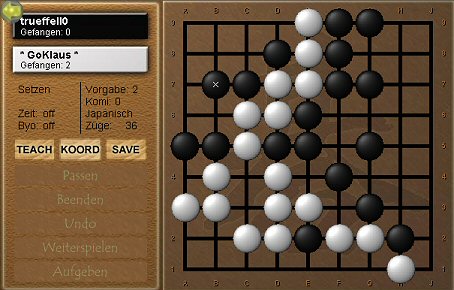
Aim of the The aim of the game is to enclose more area (free intersection points) with your stones than your opponent.
Il tabellone
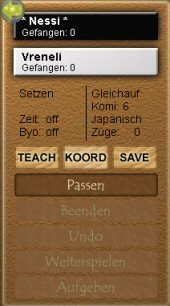
< span>To the left of the Go board is the player display: the player names and the stones hit during the game are displayed at the top.
The TEACH, KOORD and SAVE buttons are intended exclusively for the teaching mode.
The selected options are listed below the teaching buttons (see options).
The buttons below are relevant for the end of the game and are explained below.
Svolgimento
Placing a stone
The players take turns placing a stone of their color on any free intersection (exception: see suicide and knockout rule).
< span>Freedoms of stones
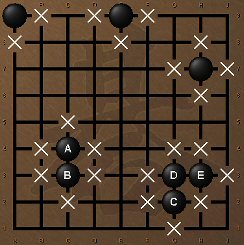
The horizontal and vertical intersection points immediately adjacent to a stone are called freedoms. This also applies to groups, i.e. stones that are connected to one another horizontally or vertically (A-B or C-D-E).
Hiting stones
{5 }If all freedoms are occupied by the opponent, the enclosed stone or group is removed from the board. If a stone or a group only has one freedom left, it is in the Atari.
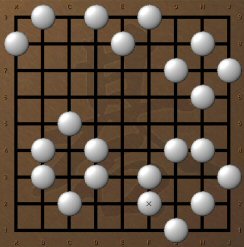
This position arises after White has occupied the marked intersections.
Suicide

It is forbidden to place stones in such a way that they are completely enclosed after the move, meaning they no longer have any freedom; unless the opponent's stones are captured, so that freedom is available again after the capture. Black is therefore not allowed to place on the intersection points marked with Set the middle?

Yes, because this move takes the eight black stones first. Afterwards, all neighboring intersections of the white stone are free.
Ko

If White makes a move on A If you hit a black stone, a so-called knockout occurs because the white stone itself then stands individually in the Atari.

Ko means that Black is not allowed to play on B immediately after White's move on A, otherwise a repetition of the position would occur. However, Black may, if still possible, play on B in the move after next and would in turn open up a knockout on A again. More on this on the page with the strategic tips.
Passare
In Go there is the possibility of waiving his right to move. A player can pass if he believes that further moves will no longer bring him any profit.
Fine del gioco
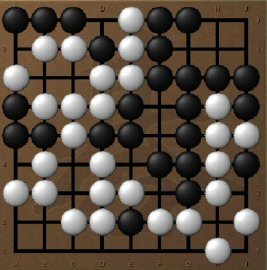
If the areas are completely demarcated and there is no possibility of scoring any more points, both players pass.
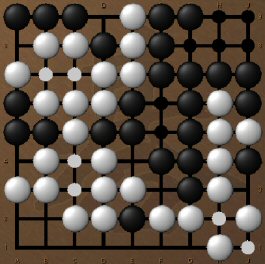
After both players have passed, the computer marks the intersection points (area points) that are completely surrounded by one color.

Now all the captured stones have to be removed from the board by clicking on them. Stones whose capture can no longer be prevented count as captured.
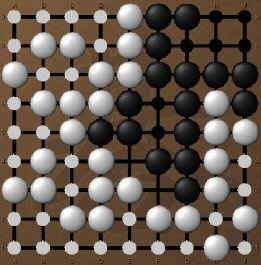
If all captured stones have been removed, click both players click “Finish” to confirm.
Undo/continue playing
If you accidentally click on the wrong stone while removing captured stones, you can undo this with Undo . If the two players do not agree on the stones they have caught, one player can click on continue playing. Then the original position is restored and the player who passed first is allowed to continue playing first.
Give up
Here in the BSW it is only possible to give up the game after 20 moves at the earliest. The opponent then wins with 20 points.
Accounting
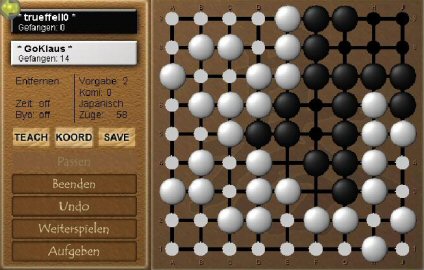
Now each player's territories are settled. For each own area point (marked by a black or white dot) there is one point. The number of prisoners (stones struck) is added to this. Furthermore, the white player receives the Komi that were set before the start of the game, which (if positive) are intended to compensate for the suit advantage of the black player.
In the picture, Black has seven points in the top right area, White has 28 territory points. In addition, there are now 14 prisoners for white and 0 prisoners for black. The intersection points E4 and F3 are neutral points and are therefore not counted. The winner receives the difference between the two results as a score, the loser gets zero points.
Opzioni
boardsize
Sets the size of the board. The options are 9x9, 13x13 and 19x19.
Standard in the BSW is 9x9.
time
Limits the Playing time per game and per player.
Values between 1min and 60min can be set. Intermediate values using /option time 12min
Off by default.
byoyomi
Byoyomi is basically a reprieve when playing with Time limit. If you set the Byoyomi to X seconds, it comes into effect as soon as the last X seconds of the set playing time (/time) are reached. If the player manages to make his move within X time, he gets X seconds again for the next move. If he doesn't make it, the game is over and the opponent wins with 20 points.
If you set the Byoyomi to zero seconds, this is a sudden death; i.e. as soon as the set playing time has expired, the game ends immediately.
Values between 0sec and 60sec can be set. Intermediate values using /option byoyomi 15sec.
Off by default.
handicap
In Go, different skill levels can be compensated for using a handicap. The weaker player receives a certain number of handicap stones, depending on the difference in strength. The default pieces are automatically placed on the game board by the computer. White then begins the game.
Values between 0 and 9 can be set.
Off by default.
komi
In a game without handicap pieces, Black always starts. To compensate for Black's suit advantage, White receives a certain number of points, which are called Komi. The set number will later be offset against the points scored by the white player.
Values from -6 to 9 can be set via the game options, and any values can be set using /option komi number.
Standard in the BSW is a Komi of 6 points.
rule
For the evaluation of a Go- There are a whole range of scoring variants around the world. In the BSW, with small exceptions, the Japanese and Chinese counting methods are available. The Japanese scoring is the standard setting and has already been described above under billing.
With the Chinese scoring, all area points as well as all the pieces on the board are scored at the end of the game (caught pieces are of course also removed beforehand). In addition, White is credited with the number of standard stones (if selected) and the set Komi is charged. When counting this way, it should be noted that there are normally no neutral points.
Related links
There is a good teaching site for Go where you can learn Go step by step can learn interactively step by step. Another interesting page can be found here, but only in English and French.

